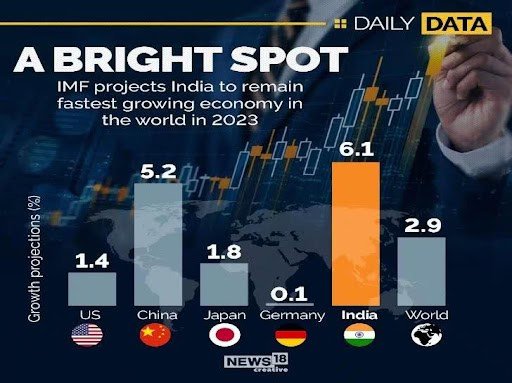
As the world’s nations strive for economic stability and dominance, India’s progress towards balanced growth and economic influence has garnered praise and significant attention. The International Monetary Fund (IMF) projects that by 2025, India will surpass Japan to become the world’s fourth-largest economy, and by 2028, it will overtake Germany, becoming the world’s third-largest economy in nominal GDP terms (IMF, World Economic Outlook, April 2025). This will not only alter the global power dynamics but also position India on the brink of an economic milestone.

According to the IMF’s April 2025 projections, India’s GDP will reach $4.187 trillion in 2025, nudging past Japan’s estimated $4.186 trillion. By 2028, India’s GDP is expected to grow to $5.58 trillion, overtaking Germany and trailing only the United States and China. In terms of purchasing power parity (PPP), India is currently the third-largest economy, considering the differences in cost of living and domestic purchasing power. India’s projected real GDP growth rate is anticipated to be around 6.8% in 2025, surpassing the growth rates of most advanced economies. In contrast, Japan and Germany are expected to experience annual growth rates of less than 1%, indicating a state of structural economic stagnation.
Factors influencing growth
Population Growth
India is a rapidly developing nation with a growing birth rate, making it the future of tomorrow. Thus, they would act as the dividend shortly. With more than 65% of its population younger than 35, India boasts one of the world’s youngest labor forces, providing ample opportunities for growth and development. The World Bank’s India Development Update for 2024 emphasises how effectively utilising this demographic dividend, if skillfully harnessed, can contribute to sustaining India’s long-term productivity. However, there are certain factors, such as education, health, and infrastructure, that can assist us in maximizing the benefits we receive.
Structural reforms and policy momentum
Since the 1990s, India’s economic liberalisation has laid a solid foundation; however, over the past decade, there has been a more significant effort to update and modernise the country’s economic framework. These factors, along with adept privatization, mergers, and acquisitions. Measures such as the Goods and Services Tax (GST), the Insolvency and Bankruptcy Code (IBC), and the production-linked incentive (PLI) schemes have simplified taxes, enhanced business resolution procedures, and stimulated domestic manufacturing. The government is also putting significant resources into infrastructure. The Union budget 2024–25 earmarked over ₹11 trillion ($130 billion) for capital spending—a 17% jump from the previous year, aiming to fuel long-term growth through roads, railways, and digital infrastructure.
Technological advancement and digital environment
India’s digital revolution is a major economic transformation that has taken place in the developing world. Platforms such as Aadhaar, UPI, and Digilocker have played a crucial role in promoting widespread digital inclusion. According to the Reserve Bank of India’s 2024 report, India witnessed over 100 billion UPI transactions last year, revolutionizing the way financial services are accessed. The adoption of digital technologies has enabled India to bypass traditional infrastructure hurdles, particularly in rural finance and governance. This has also contributed to financial inclusion for the lowest socioeconomic group in the country.

What seems to be the issue with Germany and Japan?
Due to a declining and ageing population, its economy faces deflationary pressures and escalating healthcare expenses. Despite its technological advantage, Japan’s nominal GDP growth is projected to remain below 1% in the foreseeable future (OECD 2024). This lack of progress creates an opportunity for India, whose economy is younger and more focused on consumer spending.
Germany’s manufacturing strength has consistently contributed to its economic supremacy in Europe. Unfortunately, the aftermath of the Ukraine war, increasing wages, and diminishing demand from China have disrupted the export-led growth model. Germany’s shift towards a sustainable economy and difficulties in digitizing small and medium-sized businesses pose challenges to its prospects.
India’s pathway to triumph

The substitution / the China plus one strategy
This initiative was designed to encourage domestic production, which has caused more than $30 billion in investments from renowned companies in the electronics, pharmaceuticals, and renewable energy sectors. Our goal is to replace and produce goods that we would have otherwise obtained from other countries.
Brewing start-up culture
India is home to more than 110 unicorns, with flourishing start-up ecosystems in fintech, Agritech, Saas, and Health Tech. According to NASSCOM, Indian start-ups currently employ over 1.2 million individuals.
Conclusion
The increasing number of consumers and urbanization are major factors in the growth of the market.
The middle class is estimated to increase twofold by 2030. By the year 2040, it is projected that more than 400 million individuals will migrate to urban areas, leading to a significant increase in the demand for infrastructure, housing, and services. According to the McKinsey Global Institute, India’s consumption expenditure is projected to increase by three times by 2030, reaching nearly $6 trillion.
While the ride ahead can be a bit bumpy when it comes to challenges in terms of sustainability, equality, and education, if India can match its growth with equity, sustainability, and inclusion, its rise will not just be a matter of numbers, but a model worth emulating.
Written by – Gautam Joshi
Edited by – Neelambika Kumari Devi
The post Rewiring the Economy: India’s Structural Reforms appeared first on The Economic Transcript.


